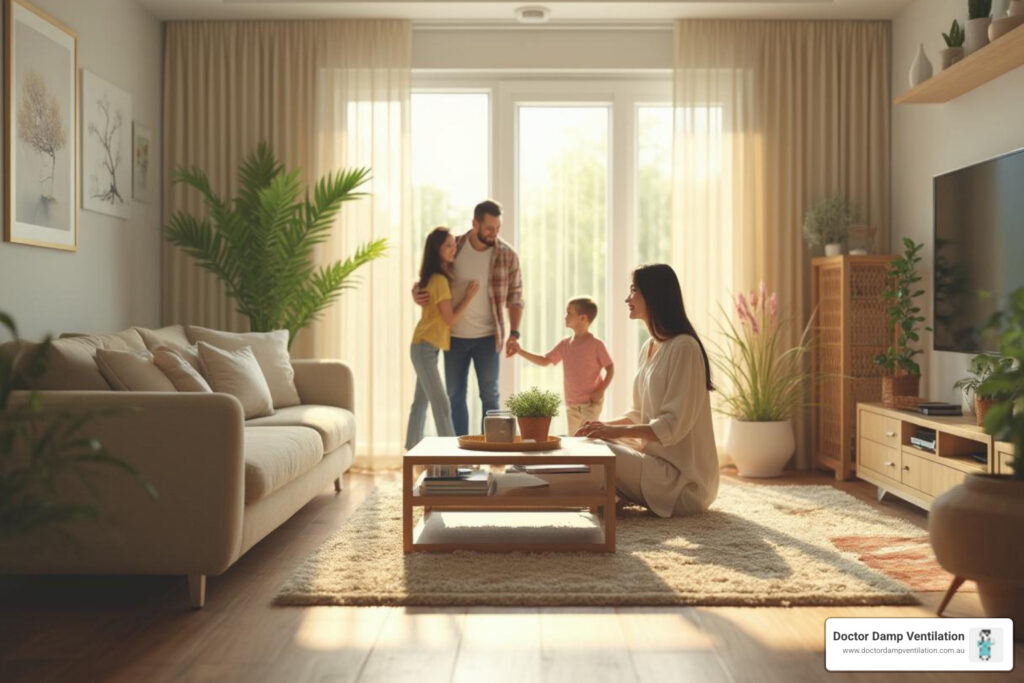Improve Indoor Air Quality: 3 Easy Steps for a Healthy Home
Why Your Home’s Air Quality Matters
If you want to improve indoor air quality in your home, you’re in the right place. It’s a critical step for a healthier life. Most people spend about 90% of their time inside, whether at home, work, or school. This makes the air we breathe indoors hugely important.
The truth is, indoor air can be much dirtier than you think. It’s often two to five times more polluted than the air outside. Sometimes, indoor pollutant levels can even be 100 times higher! These hidden pollutants can greatly affect your health and comfort.
So, how can you improve indoor air quality quickly? Here are the three core strategies:
- Source Control: Stop pollutants at their origin.
- Improved Ventilation: Bring in more fresh air.
- Air Cleaners/Filtration: Remove particles from the air.
Understanding these basics is the first step to a healthier home.
I’m Scott Lambert, and for over two decades, my work at Dr. Damp has focused on helping Australians improve indoor air quality by tackling moisture and building health issues. My expertise ensures homes, especially in places like Sydney, are healthy and comfortable spaces.
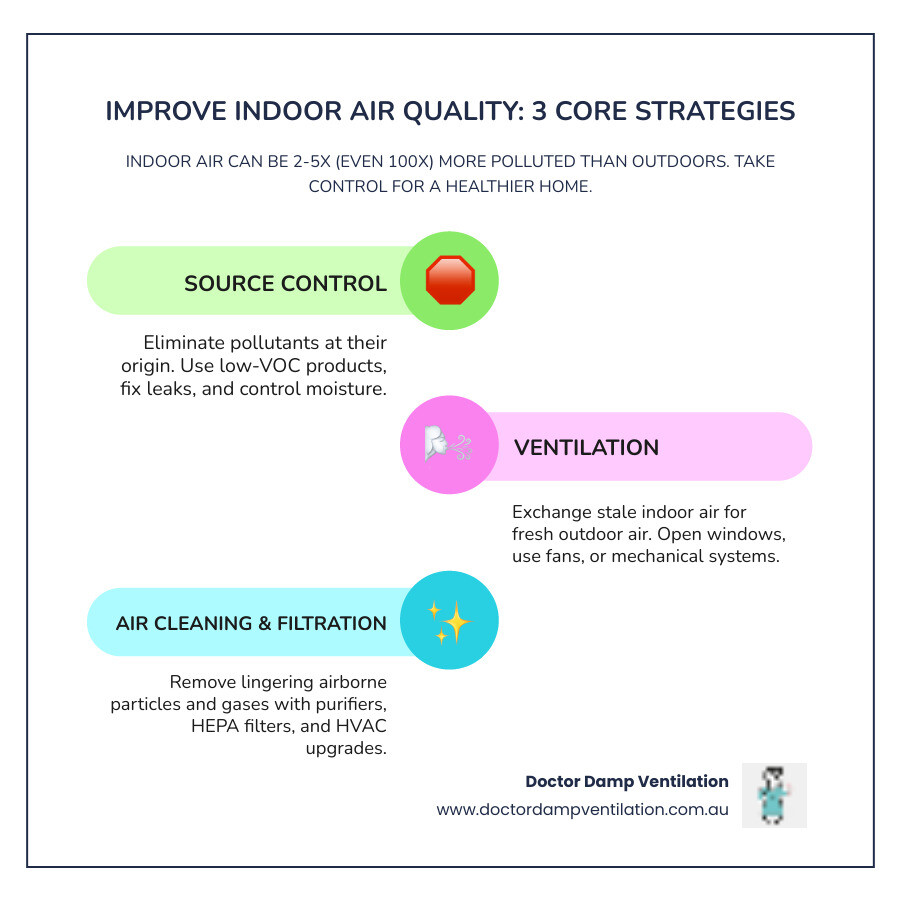
Understanding the Invisible Threats: Common Sources of Indoor Air Pollution
Before we can truly improve indoor air quality, it’s important to shine a light on the hidden culprits making our indoor spaces less healthy. Our homes, while we cherish them as safe havens, can sometimes be surprisingly full of unseen pollutants. These aren’t always things you can spot with the naked eye, but their effects can certainly be felt, impacting everything from how well we breathe to how sharply we think.
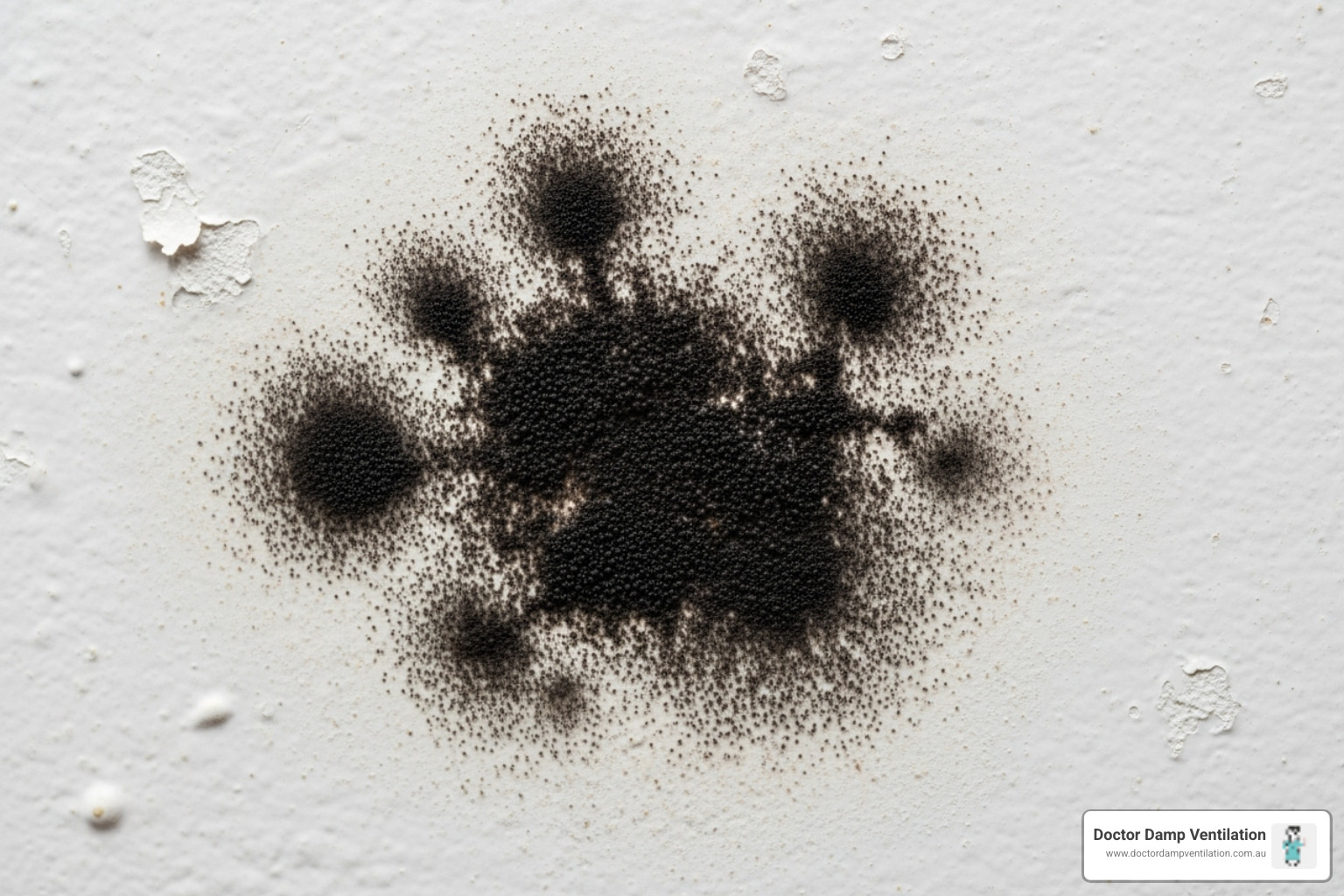
So, what exactly are these invisible guests? Let’s take a closer look at some of the common sources of indoor air pollution that might be lurking in your Sydney home:
First up are Volatile Organic Compounds (VOCs), gases that escape from everyday items. That “new paint” smell is a prime example. VOCs are released from paints, cleaning products, air fresheners, new carpets, and furniture made with composite wood. They can cause eye, nose, and throat irritation, headaches, and nausea. Long-term exposure to some VOCs, like formaldehyde found in building materials, poses more serious health risks.
Then there’s Mould and Mildew. Wherever there’s moisture, mould can grow, releasing spores and mycotoxins into the air. It thrives in damp areas like bathrooms, basements, and places with leaks. Exposure can trigger allergic reactions, asthma attacks, and respiratory infections. A significant 35% of Australians face mould problems at home, making it a serious health concern.
Don’t forget about Dust Mites. These microscopic critters thrive in bedding, carpets, and upholstered furniture, feeding on dead skin cells. Their droppings are potent allergens that can cause respiratory problems, asthma flare-ups, and fatigue.
If you share your home with furry friends, you’re also likely familiar with Pet Dander. These are tiny flakes of skin, hair, or feathers shed by pets. This common allergen can float around in the air and settle on surfaces, often causing allergic reactions in sensitive individuals.
Next, we have Combustion Pollutants from fuel-burning appliances like gas stoves, fireplaces, and heaters. These release dangerous pollutants like carbon monoxide (CO), an odorless gas that can be fatal, and nitrogen dioxide (NO2). Homes with gas stoves can have higher NO2 levels than the outdoors.
An invisible, odorless gas called Radon Gas is a silent threat, seeping into homes from the ground through foundation cracks. Exposure is a leading cause of lung cancer, making testing crucial since it cannot be seen or smelled.
Pesticides used indoors or tracked in from outside can linger in the air and on surfaces. These chemicals are harmful to humans, with health effects varying based on the type and level of exposure.
Finally, Secondhand and Thirdhand Smoke from indoor smoking releases harmful chemicals. Secondhand smoke harms respiratory health and increases lung cancer risk, while thirdhand smoke is the toxic residue left on surfaces, which also poses a health risk.
For a more in-depth look at specific pollutants and their health impacts, the EPA offers excellent resources on Common indoor pollutants and their health effects.
The Unique Challenge in Sydney Homes
Sydney’s climate, particularly its high humidity, presents a significant challenge. Coastal suburbs like Bondi, Manly, and Cronulla experience high moisture levels, but humidity affects the entire city, from Newtown to Parramatta and Penrith, creating ideal conditions for mould. Older homes in areas like Glebe, Balmain, and Surry Hills often have poor ventilation or older plumbing, leading to persistent dampness and musty odours that undermine efforts to improve indoor air quality.
Furthermore, bushfire smoke, as seen in the 2019/2020 summer, can cause extreme levels of particulate matter inside homes across the region, from Blacktown to Campbelltown. Sealing homes can trap these pollutants. This underscores the need for local solutions that address both indoor and outdoor air. Our expertise in mould removal and ventilation helps homes across Sydney, from Vaucluse to Liverpool, manage these unique challenges.
The Three Pillars to Improve Indoor Air Quality
To improve indoor air quality, the U.S. Environmental Protection Agency recommends a cost-effective, three-pronged approach: Source Control, Ventilation, and Air Cleaning. These pillars work together to create a comprehensive, long-term solution. Source control stops pollutants from entering, ventilation exchanges stale air for fresh, and air cleaning removes any remaining particles.
Pillar 1: Source Control – Eliminating Pollutants at the Root
Source control is the most effective and budget-friendly way to improve indoor air quality because it stops pollutants at their origin.
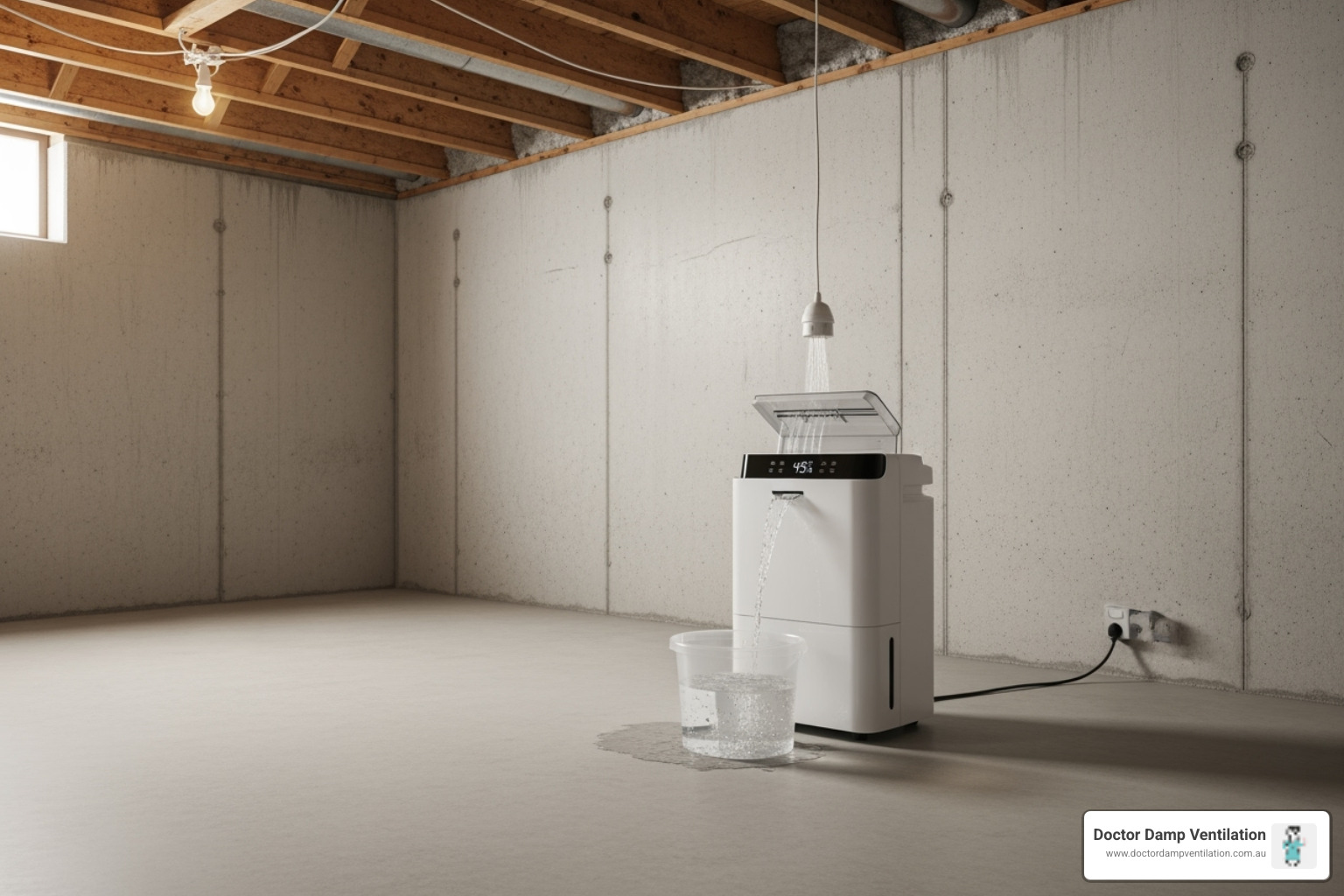
Controlling dampness and fixing leaks is crucial in Sydney. In suburbs like Randwick, Strathfield, and Hurstville, a small leak can lead to major mould issues. Moisture in sub-floors or walls creates a breeding ground for mould and mildew, causing musty smells. Our expertise at Doctor Damp Ventilation tackles these issues with professional mould removal and solutions for rising damp, making homes feel cleaner and fresher.
Other key source control steps include:
- Choosing low-VOC products: When renovating or buying furniture, look for low- or no-VOC labels to reduce chemical off-gassing.
- Using natural cleaning products: Simple ingredients like vinegar and baking soda clean effectively without harsh fumes.
- Maintaining fuel-burning appliances: Ensure gas stoves are used with exhaust fans and that all fuel-burning appliances are serviced regularly to prevent dangerous pollutants like carbon monoxide.
Pillar 2: Ventilation – Exchanging Stale Air for Fresh
Ventilation is essential for diluting and removing indoor pollutants, as most standard heating and cooling systems simply recirculate stale air. You must intentionally bring fresh air into your home.
Natural ventilation involves opening windows and doors to create cross-breezes, which works well in breezy suburbs like Redfern or Glebe. However, always check local air quality reports first, as opening windows during bushfire season or on high-pollution days can worsen indoor air.
Mechanical ventilation offers more control. Ensure kitchen and bathroom exhaust fans vent directly outside. For well-sealed modern homes, like those in Macquarie Park or Wentworth Point, whole-house systems provide consistent fresh air without significant energy loss.
Sub-floor and roof ventilation are critical but often overlooked in Sydney homes. In areas like Canterbury and Hurstville, poor sub-floor ventilation is a common cause of dampness and musty odours. Our sub-floor ventilation systems remove damp, stagnant air from under your home, while our roof ventilation prevents heat and moisture buildup in the attic, protecting your entire home’s air quality.
The Department of Energy has excellent resources on whole-house ventilation if you want to dive deeper into mechanical ventilation options.
Pillar 3: Air Cleaning & Filtration – Trapping Lingering Particles
Air cleaning and filtration act as a final safety net, trapping airborne particles that source control and ventilation might miss.
Key methods include:
- Air purifiers: Use portable units with “true HEPA” filters in high-traffic rooms like bedrooms. HEPA filters are the gold standard, trapping over 99% of particles like dust, pollen, and mould spores.
- HVAC filters: Upgrade your system’s filter to a MERV 13 rating to capture smaller particles. Remember to change filters regularly to maintain effectiveness and avoid system strain.
- Activated carbon filters: These are essential for removing gases, odours, and VOCs. The best purifiers combine HEPA and activated carbon filters for comprehensive cleaning.
At Doctor Damp Ventilation, we can help you choose the right air purification solutions, including specialized air purification for air conditioners.
Your Action Plan: Practical Steps for a Healthier Home
Taking action is what truly makes a difference. Here is a practical plan with everyday steps to improve indoor air quality in your Sydney home:
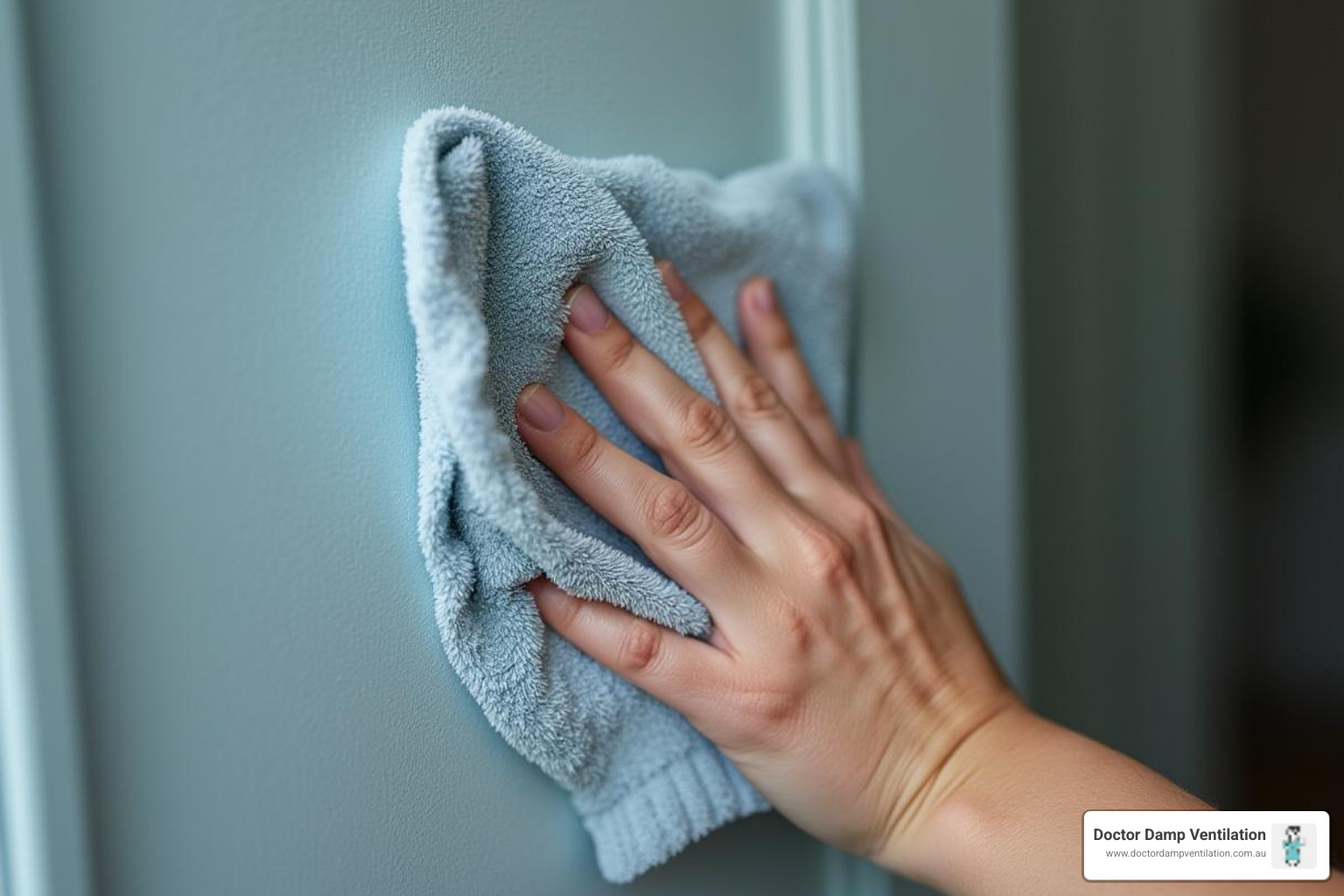
Clean regularly and strategically. Dust and allergens accumulate quickly, so make it a routine to fight back. Vacuum carpets and rugs at least weekly with a HEPA filter vacuum to trap dust effectively. Use a damp microfiber cloth for surfaces to capture dust instead of spreading it. Wash all bedding weekly in hot water (at least 54°C) to kill dust mites, and consider using dust mite-proof covers on mattresses and pillows.
Control humidity levels. In Sydney’s humid climate, this is crucial. Aim for a relative humidity between 30-50% to prevent mould and dust mites without causing dry skin or irritation. Use a dehumidifier in damp areas like basements, sub-floors, and bathrooms, particularly in humid suburbs like Lakemba or Fairfield. Ensure bathrooms are well-ventilated and address any mould growth immediately.
Go fragrance-free. Many air fresheners, scented candles, and cleaning products release VOCs. Instead of masking odours, eliminate their source and choose fragrance-free products. The air quality benefits of items like beeswax candles or salt lamps are minimal and still debated.
Test for radon. Since radon is an invisible gas, testing is the only way to know if it’s present. DIY test kits are available, or you can hire a professional. If levels are high (4 pCi/L or higher), professional remediation is necessary.
Maintain your HVAC system. Regularly change your HVAC filters and schedule annual professional maintenance. This ensures your system runs efficiently and doesn’t circulate pollutants. Consider having your air ducts cleaned every 5-10 years if you’ve had significant dust or mould issues.
Check outdoor air quality reports. Before opening windows, especially in busy areas like the Sydney CBD or near industrial zones in Granville, check for high pollution or pollen days. On these days, it’s better to keep windows closed and rely on your indoor filtration.
Clear clutter. Less clutter means fewer places for dust and allergens to collect. A tidy home is a healthier home.
For a comprehensive guide to making your home healthier, including tips specifically for allergy and asthma sufferers, check out the Healthier Home Checklist from AAFA.
Frequently Asked Questions about Improving Indoor Air Quality
We get a lot of questions about indoor air quality, and we’re happy to clear the air (pun intended!). Here are some common queries and our expert answers:
Are houseplants really effective for cleaning the air?
This is a popular question, but the answer is nuanced. The idea that houseplants are powerful air purifiers stems from a 1980s NASA study conducted in sealed chambers. However, recent research shows their impact in a typical home is quite limited. You would need hundreds of plants in an average room to replicate the study’s results.
While beautiful, a plant’s air-cleaning ability is far less effective than simply opening a window. Furthermore, over-watered plants can lead to mould growth in the soil, releasing spores that can worsen allergies and respiratory issues. So, enjoy plants for their aesthetic, but don’t rely on them to improve indoor air quality. Prioritize source control and ventilation instead.
What is the difference between disinfecting and sterilizing the air?
These terms have distinct meanings for home health.
Disinfecting reduces harmful microorganisms (bacteria, viruses) to a safe level. It doesn’t eliminate all microbes but significantly lowers their count. Air purifiers with UV-C light, for example, aim to disinfect the air.
Sterilizing, in contrast, eliminates all microbial life, including spores. This rigorous process is typically reserved for medical or lab settings and isn’t practical or necessary for a home.
Air purifiers that claim to “kill” germs are disinfecting, not sterilizing. Be cautious, as some UV purifiers can produce ozone, a harmful lung irritant. Always choose an ozone-free device. For specific concerns about airborne pathogens, learn about our Virus Protection Service.
How often should I change my air filters?
This is a crucial maintenance step. As a general rule, check your HVAC filters monthly and replace them every 1 to 3 months to improve indoor air quality and system efficiency.
However, you may need to change them more frequently based on these factors:
- Pets: Homes with pets may require filter changes every 1-2 months due to dander.
- Allergies or Asthma: Change filters monthly to reduce airborne triggers.
- Smokers: Monthly changes are necessary to handle smoke particles.
- Outdoor Air Quality: In areas with high pollution, like near busy roads in Blacktown or during bushfire season, filters get dirty faster.
- Filter Type: Higher-rated filters like MERV 8-13 capture more particles but may clog faster. Ensure your HVAC system can handle the MERV rating you choose to avoid restricting airflow.
A clean filter is a cost-effective way to protect your family’s health and lower energy bills!
Breathe Easier in Your Sydney Home
Phew! We’ve covered a lot of ground today, haven’t we? From those sneaky, invisible pollutants that can lurk in our homes to the practical steps you can take to transform your space into a haven of fresh air. It all boils down to a powerful trio of strategies: Source Control, Ventilation, and Air Cleaning & Filtration. Think of them as your home’s personal air-guardians, working together to keep things clean.
Taking a proactive approach to your indoor air isn’t just about ticking boxes; it’s about investing in a healthier, happier life for you and your loved ones. Imagine fewer sniffles, deeper sleep, and a home that just feels right, a place where you can truly relax and thrive. The benefits of breathing truly cleaner air are immense, from helping to soothe allergies and asthma symptoms to simply boosting your overall sense of well-being. It’s a choice that pays dividends for your family’s long-term health and comfort.
At Doctor Damp Ventilation, we’re genuinely passionate about helping Sydneysiders achieve exactly that – a truly healthy home. Whether you’re struggling with persistent dampness in an older property in Newtown, looking to upgrade your sub-floor ventilation in Penrith to tackle musty smells, or simply want to ensure the air is pristine in your family home in Mosman, we’re here to guide you. Our expertise in mould removal, damp solutions, and cutting-edge ventilation systems means we’ve got Sydney covered. We work across the Northern Beaches (from Manly to Dee Why), the Inner West (Leichhardt, Balmain), the Eastern Suburbs (Bondi, Double Bay), and out to the Greater West (Liverpool, Mount Druitt), ensuring that no matter where you are, you can create a truly Healthy Home.
Don’t let poor indoor air quality be an invisible burden that weighs you down. Take control, take a deep breath, and enjoy the comfort and health of a truly clean home. Ready to improve indoor air quality in your space? Contact us for a consultation today. We’d love to help!

